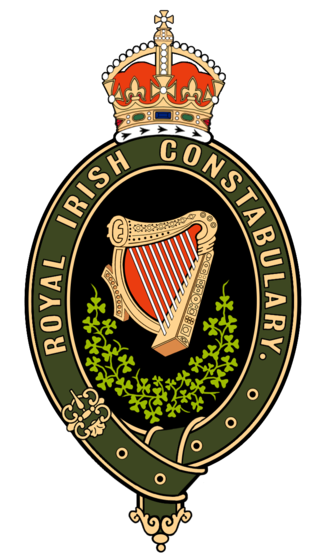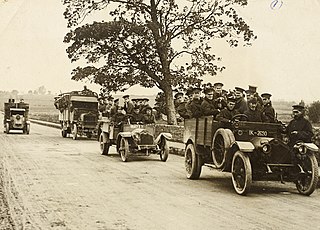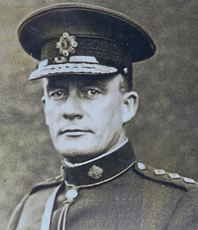
Na Fianna Éireann, known as the Fianna, is an Irish nationalist youth organisation founded by Constance Markievicz in 1909, with later help from Bulmer Hobson. Fianna members were involved in setting up the Irish Volunteers, and had their own circle of the Irish Republican Brotherhood (IRB). They took part in the 1914 Howth gun-running and in the 1916 Easter Rising. They were active in the War of Independence and many took the anti-Treaty side in the Civil War.

The Irish War of Independence or Anglo-Irish War was a guerrilla war fought in Ireland from 1919 to 1921 between the Irish Republican Army and British forces: the British Army, along with the quasi-military Royal Irish Constabulary (RIC) and its paramilitary forces the Auxiliaries and Ulster Special Constabulary (USC). It was part of the Irish revolutionary period.

Bloody Sunday was a day of violence in Dublin on 21 November 1920, during the Irish War of Independence. More than 30 people were killed or fatally wounded.

The Royal Irish Constabulary was the police force in Ireland from 1822 until 1922, when all of the country was part of the United Kingdom. A separate civic police force, the unarmed Dublin Metropolitan Police (DMP), patrolled the capital and parts of County Wicklow, while the cities of Derry and Belfast, originally with their own police forces, later had special divisions within the RIC. For most of its history, the ethnic and religious makeup of the RIC broadly matched that of the Irish population, although Anglo-Irish Protestants were overrepresented among its senior officers.

The Garda Síochána is the national police service of Ireland. It is more commonly referred to as the Gardaí or "the Guards". The service is headed by the Garda Commissioner who is appointed by the Irish Government. Its headquarters are in Dublin's Phoenix Park.

The Dublin Metropolitan Police (DMP) was the police force of Dublin, Ireland, from 1836 to 1925, when it was amalgamated into the new Garda Síochána.

The Auxiliary Division of the Royal Irish Constabulary (ADRIC), generally known as the Auxiliaries or Auxies, was a paramilitary unit of the Royal Irish Constabulary (RIC) during the Irish War of Independence. It was founded in July 1920 by Major-General Henry Hugh Tudor and made up of former British Army officers, most of whom came from Great Britain and had fought in the First World War. Almost 2,300 served in the unit during the conflict. Its role was to conduct counter-insurgency operations against the Irish Republican Army (IRA), acting mainly as a mobile striking and raiding force. It operated semi-independently of the RIC and was mainly deployed to southern and western regions where fighting was heaviest.

Joseph McGrath was an Irish politician and businessman. He was a Sinn Féin and later a Cumann na nGaedheal Teachta Dála (TD) for various constituencies; Dublin St James's (1918–1921), Dublin North West (1921–1923) and Mayo North (1923–1924), and developed widespread business interests.
The Dublin Guard was a unit of the Irish Republican Army during the Irish War of Independence and then of the Irish National Army in the ensuing Civil War.

This is a timeline of the Irish War of Independence of 1919–21. The Irish War of Independence was a guerrilla conflict and most of the fighting was conducted on a small scale by the standards of conventional warfare.

The executions during the Irish Civil War took place during the guerrilla phase of the Irish Civil War. This phase of the war was bitter, and both sides, the government forces of the Irish Free State and the anti-Treaty Irish Republican Army (IRA) insurgents, used executions and terror in what developed into a cycle of atrocities. From November 1922, the Free State government embarked on a policy of executing Republican prisoners in order to bring the war to an end. Many of those killed had previously been allies, and in some cases close friends, of those who ordered their deaths in the civil war. In addition, government troops summarily executed prisoners in the field on several occasions. The executions of prisoners left a lasting legacy of bitterness in Irish politics.

Eamon "Ned" Broy was successively a member of the Dublin Metropolitan Police, the Irish Republican Army, the National Army, and the Garda Síochána of the Irish Free State. He served as Commissioner of the Gardaí from February 1933 to June 1938. He later served as president of the Olympic Council of Ireland for fifteen years.

David Neligan, known by his soubriquet "The Spy in the Castle", was a crucial figure involved in the Irish War of Independence (1919–21) and subsequently became Director of Intelligence for the Irish Army after the Irish Civil War (1922–23).
This is a timeline of the Irish Civil War, which took place between June 1922 and May 1923. It followed the Irish War of Independence (1919–1921), and accompanied the establishment of the Irish Free State as an entity independent from the United Kingdom of Great Britain and Ireland.
The Special Detective Unit (SDU) is the main domestic security agency of the Garda Síochána, the national police force of Ireland, under the aegis of the Crime & Security Branch (CSB). It is the primary counter-terrorism and counter-espionage investigative unit within the state. The Special Detective Unit superseded the Special Branch, which itself replaced the older Criminal Investigation Department (CID), which was founded in 1921. They work in conjunction with the Defence Forces Directorate of Military Intelligence (J2) – Ireland's national intelligence service – on internal matters. The unit's headquarters are in Harcourt Street, Dublin City.
Michael Joseph Costello was an Irish rebel and military leader during the Irish War of Independence.
The Citizens' Defence Force (1922) was a unit of former British Army soldiers and Irish Volunteers organised by Ireland as a semi-secret group of about 100 operatives. It was financed from the Secret Service budget to mount foot patrols and gather intelligence, and was eventually absorbed into the CID.

Oriel House, Westland Row is a building at the intersection of Westland Row and Fenian Street in Dublin. It is owned by Trinity College Dublin and serves as the headquarters for the Connect Centre for Future Networks and Communications, the Science Foundation Ireland research centre.
G (detective) Division was a plainclothes divisional office of the Dublin Metropolitan Police concerned with detective police work. Divisions A to F of the DMP were uniformed sections responsible for particular districts of the city.

On 25 May 1921, during the Irish War of Independence, the Custom House in Dublin was occupied and then burnt in an operation by the Irish Republican Army (IRA). The Custom House was the headquarters of the Local Government Board for Ireland, an agency of the British administration in Ireland, against which the IRA was fighting in the name of the self-proclaimed Irish Republic. The operation, involving over 100 IRA volunteers, was a propaganda coup for the republicans but a military disaster for the IRA in the Irish capital. A force of British Auxiliaries quickly arrived and a gun battle erupted. Five IRA volunteers were killed, along with three civilians, and about 80 volunteers were captured.














